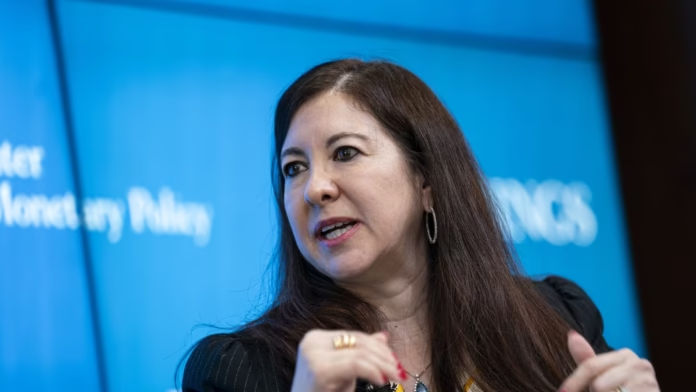Fed governor Adriana Kugler resigns from her position at the Federal Reserve, effective August 8, 2025, creating a significant vacancy on the central bank’s board of governors just months before her term was set to expire.
Kugler was appointed by former President Joe Biden in 2023 and her term was slated to end in January 2026. The unexpected departure gives President Donald Trump an earlier-than-anticipated opportunity to shape monetary policy by appointing a new governor who may align more closely with his economic priorities.
Table of Contents
Early Departure Creates Strategic Opening
In a letter addressed to Trump, Kugler, 55, did not state a reason for her resignation. The Federal Reserve announced her decision on Friday, noting that she has served as governor since September 13, 2023.
The timing proves particularly significant as Trump has been vocal about his desire for lower interest rates. Kugler’s resignation opens a vacancy that President Donald Trump can fill as he presses his campaign to drop interest rates.
Impact on Federal Reserve Leadership
The Fed board consists of up to seven members — called governors — with staggered terms of 14 years. Kugler’s departure reduces the current composition and provides Trump with the chance to install a policymaker who supports his economic vision.
The resignation comes at a critical juncture for monetary policy. Economic analysts note that Fed governors play crucial roles in setting interest rates and guiding the nation’s financial stability measures.
Kugler’s Brief but Notable Tenure
During her nearly two-year service, Kugler participated in key decisions regarding interest rate adjustments and inflation management. “I am especially honored to have served during a critical time in achieving our dual mandate of bringing down prices and keeping a strong and resilient labor market,” Kugler stated.
Her academic background and policy expertise brought valuable perspectives to Fed deliberations. Before joining the Federal Reserve, she held prominent positions in economic research and policy development.
Strategic Implications for Trump’s Economic Agenda
The vacant governor position allows Trump to advance his monetary policy preferences more effectively. Fed governors influence decisions on:
- Interest rate adjustments
- Banking regulation oversight
- Economic stimulus measures
- Financial stability protocols
Trump’s appointee will likely support policies that align with his administration’s economic priorities, potentially including more aggressive rate cuts to stimulate growth.
Looking Ahead: Selection Process
The president must nominate a replacement who requires Senate confirmation. Given Republican control of the Senate, Trump’s nominee is expected to face a relatively smooth confirmation process.
Market observers will closely watch for signals about Trump’s selection criteria and timeline. The choice could significantly impact Federal Reserve dynamics and future monetary policy directions.
Broader Context for Central Banking
Kugler’s spot was not scheduled to come open until January 2026, making this early resignation particularly noteworthy for Fed watchers. The departure reflects the ongoing political tensions surrounding monetary policy and central bank independence.
Fed governance typically maintains stability through staggered terms and bipartisan appointments. However, early resignations can shift the balance and provide administrations with unexpected opportunities to influence policy direction.
The Federal Reserve’s dual mandate of price stability and full employment remains unchanged, but personnel changes can affect how these goals are pursued and prioritized.
This development adds another layer to the complex relationship between the Trump administration and Federal Reserve leadership, as the president continues advocating for monetary policies that support his broader economic strategy.
Stay tuned for updates on Trump’s nomination process and how this leadership change might influence upcoming Federal Reserve decisions that affect markets and the broader economy.
